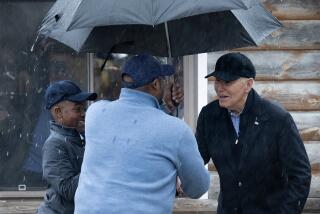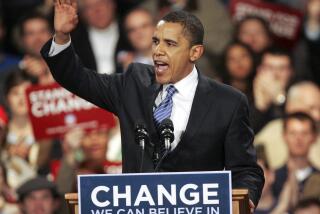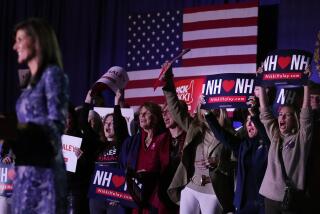Iowa presidential campaign shifts to state’s rural northwest
Eric Skoog has seen it all. The owner of the historic Cronk’s Cafe has greeted presidents as they walked through his restaurant’s doors, chatted with former Sen. Bob Dole about their fraternity’s secret handshake, and kept a detailed log of every political candidate to visit the eatery over the last three decades. A framed front page of the local newspaper featuring a picture of Skoog and then-Sen. Joe Biden hangs in the lobby.
His restaurant is a community gathering spot, favored by the Rotary, the Republican women’s group and others. But the candidates haven’t been coming through nearly as frequently as they used to, Skoog said, sitting in a back office adorned with campaign signs for Republican Steve Forbes and Democrat John F. Kerry. Not like four years ago, when Iowa swarmed with candidates.
“You kind of miss it,” Skoog said. “We’re rural. We aren’t metropolitan voters. To get candidates out is really a big deal. People want to stand up and ask questions.”
But a campaign that has largely focused on the more densely populated center of the state is now shifting to the northwest area, which is replete with sharply conservative voters — the type most likely to turn out on a freezing Iowa winter night to caucus for their favored candidate.
Michele Bachmann just wrapped up a three-day bus tour through northwestern Iowa, where she used her Iowa roots — in the east, but still in-state — to try to woo supporters in coffee shops, libraries and community centers. The small-town gatherings, where Bachmann strode through rows of folding chairs so she could shake every single voter’s hand, had a far different vibe from her made-for-TV events in larger cities this summer.
“We’re family here, so just go ahead, move around, move your chair, feel free to because you can’t see anything,” she said when she presented a slide show on the costs of illegal immigration that was not visible to some supporters at a rally in Perry.
On Thursday, former Massachusetts Gov. Mitt Romney is making his first trip to northwestern Iowa this year. Texas Gov. Rick Perry is also expected to swing through the region before the end of the month.
Voters in bigger states may erroneously see Iowa as one big cornfield, but the state’s stereotype is true in the rural northwest, which is replete with sprawling expanses of farmland. It is an area dotted with picturesque barns, massive grain towers and small towns whose names are heralded on water towers, where a cellphone signal can be absent for hours.
Part of the reason the area has been ignored to date is Romney’s decision not to spend the millions across Iowa — yet anyway — that he did during his first presidential campaign in 2007.
“The race started late. You had people put their toe in the water and pull it back out again,” noted Rep. Steve King, an influential conservative, still neutral in the race, who represents northwest Iowa. “Four years ago, you had Mitt Romney here with full force, and anyone competing with him had to go out there and cover as much territory as they could. I think that’s different — who is setting the pace in Iowa right now? That’s the question.”
Former Pennsylvania Sen. Rick Santorum is the sole candidate who has aggressively pursued these voters — speaking to them in diners, worshiping with them in church, and personally calling local GOP activists — leading many top Republicans to predict that he will fare better than expected in the state’s caucuses.
“He’s kind of like a turtle; he just keeps working, working, working,” said Iowa Gov. Terry Branstad. “He’s got a lot more support than I think the national media really appreciates. I think he is going to surprise some people.”
Efforts similar to Santorum’s are vital to voters in the rural counties, Branstad said.
He speaks from experience. In his 2010 race, he ran up huge numbers in the northwest, which offset votes in more liberal areas of the state. In Sioux County, one of the most Republican regions in the nation, Branstad received 11,238 votes, while his Democratic rival, incumbent Gov. Chet Culver, received 1,385.
“If they resonate well with the population out here, they are going to pick up some big numbers,” said Sam Clovis, an influential Sioux City radio host and a professor at Morningside College.
These voters are not swayed by television ads or mailers — they expect to individually meet candidates, and many say they would have a hard time supporting a politician who did not visit the region.
Anita Bomgaars, 56, is particularly piqued at Romney.
“Why is he scared of coming to small-town Iowa?” asked the Orange City resident. “This is where you see what people are like.”
Lillian Green, 80, is proof that visits can make a difference. Though initially unwilling to support Bachmann, she attended an event for the Minnesota congresswoman in Sioux Center.
“As a woman, I thought she couldn’t handle it,” said the retired ceramic shop owner from Boyden. But after listening to Bachmann speak at a small Christian university, Green said she planned to caucus for her. “I think this woman has got what it takes,” she said.
But many remain undecided, awaiting the attention they have come to expect.
“They need to come here and have plain talk,” said Denise Peters, an artist who draws landscape pastels in Denison. “None of this blowing hot air at us. Give it to us straight.”
More to Read
Start your day right
Sign up for Essential California for news, features and recommendations from the L.A. Times and beyond in your inbox six days a week.
You may occasionally receive promotional content from the Los Angeles Times.







